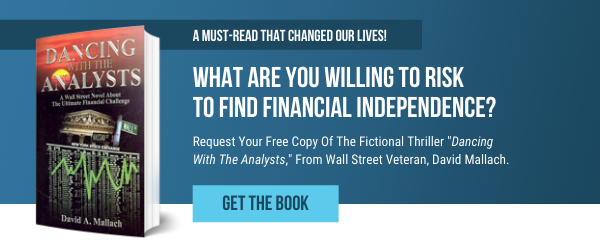If you pay attention to the financial media or any news that’s market-related, you may notice that the predominant benchmark for performance is the S&P 500.
The industry has us comparing everything to the S&P 500: your portfolio, your shoe size (just kidding), back to your portfolio – oh yeah, and once again let’s see how is the S&P 500 now?! To me, at least, it feels like every waking moment of the day is devoted to how the S&P 500 is doing.
What Benchmark Should I Use to Measure Investment Success?
If you’re paying such close attention to the S&P 500 you may be losing sight of what’s most important to your own investing success. In my view, the most useful benchmark is the average historical rate of inflation plus the percent of your portfolio that you need to draw upon for living expenses. Did you hear anything about the S&P 500 in this statement? No! Your benchmark for success has nothing to do with the S&P 500 or any stock market index. Your benchmark for success has everything to do with how you allocate your portfolio so that you can achieve your benchmark.
Even though we are seeing much higher inflation numbers at this moment in time, the historical average rate of inflation is about 3%. That means if I have a million dollars and I need to take out $50,000 a year pre-tax to live off my investment (above Social Security and any kind of other income), then 50,000 as a fraction of my 1-million-dollar principal, represents a 5% withdrawal. Add to the 5% that my investment needs to produce another 3% to keep up with inflation –that’s five plus three, which makes eight. I’m keeping things simple here, so that it’s clear. Eight percent (in this example) is the long-term benchmark I have to hit. What the S&P 500 does in any given day, week, month, year doesn't matter.
The only thing that matters is how I achieve my personal benchmark; all I care about is having a successful retirement without outliving my assets. If your benchmark is not related directly to your goals, meaning if you're looking to the outside in order to figure out what you need then the basis for your decision-making is potentially faulty.
Are Index Funds Safe?
The S&P 500 is what’s known in our business as an index, a benchmark. Index funds have grown enormously in size and type over the past twenty years. Whether it’s the S&P 500, the Russell, the NASDAQ, or some other benchmark, there’s an index for just about everything you can invest in.
Now that's not by mistake. I think it’s directly related to the popularity of passive management. Passive management refers to designing one’s portfolio to be representative of a market-weighted index. We are not going to get into the passive versus active management debate here, other than to say that indexing picked up a lot of steam with mainstream investors led by Vanguard, the mutual fund company founded by “Jack” Bogle. Bogle pioneered passive investing by creating low-cost mutual funds.
He wrote a groundbreaking book where he presented research that said the 80-plus percent of active managers don’t outperform their comparable index. It was simple enough that even the average investor could follow. It was also easy to imagine some big, bad, overpaid portfolio managers driving their Porsches, or spending time on their yachts on the money they earned on their overpriced funds. Who wouldn’t say, “Well, I can just invest in an index fund for a tenth of the price and do just as well if not better.”
Misunderstanding Investment Benchmarks Can Be Risky
I’m not denying the fact that there are great managers out there and some not-so-great managers. What I hope we can agree upon is that the future is unknown and unknowable and making an investment decision based upon fund management expenses also falls into the category of potentially faulty decision-making. The point is this: whether you index or whether you use active management, whether you pay a fee or use low-cost funds, the real question you need to answer is what is your own personal benchmark? That question is followed by: what type of security or securities do you need to achieve your personal benchmark?
How Do I Measure Successful Investing Using these Benchmarks?
To determine how you will need to invest to hit your personal benchmark for success, you need to look at how different asset classes have performed over time. First, bonds – certainly after inflation- have performed at about one-third of the rate of stocks. If the nominal rate of return of stocks is historically around 10%, then the real rate of return is about 7%. The real rate of return accounts for the impact of inflation, for which we are also using a long-term average of 3%. (Again, ten minus three gives us seven.) So if the nominal rate of return of bonds is between five and six percent, then the real (after-inflation) rate of return of bonds is like two, two and a half percent.
It doesn’t take a mathematician to point out that bonds won’t get you to your 8% benchmark. If you went through this exercise and looked at the other asset classes, you would discover that nothing other than equities will get you to your personal benchmark. There's literally no contest when it comes to the asset class that has proven to be the best way to produce retirement income that outpaces the rate of inflation: it’s a diversified portfolio of equities. There's no question about it. The average historical return of equities has been around 10% per year, that is simply a fact.
If you've now concluded that you do need equities predominantly for your portfolio to achieve your personal benchmark for success, then whether you do it passively via an index, or if you opt for active management – is not material. If you're diversified and you're invested in the asset class that can get the job done for you to meet your goal, you should be in a good place. At Beck Bode, we take a little bit of a unique approach to achieving what we consider proper diversification. I speak about this in other blogs, so for today let’s just say we think that owning a fund that includes 500 securities might be too much. The number of stocks we include in our definition of the properly diversified portfolio is fifteen. Any more than that, and you are over-diversifying your portfolio, which really means that you are potentially diluting your future returns. But that’s another story for another day!
Don’t Fall Into the Comparison Trap
The mistake that a lot of people make is that when they meet with a financial advisor, they come with some preconceived ideas about performance. Often, they are thinking of how their neighbor’s portfolio is supposedly doing, or what their in-laws are doing with their money, or insert some other relative or point of reference that has nothing to do with their own scenario.
People love to have a benchmark with which to compare themselves. Now, having a benchmark is not bad. The only thing is that you have to use numbers that are realistic and applicable to your own scenario – not your in-laws, not your neighbor’s, not your co-workers'. I think this need for having some benchmark has to do with a need for certainty. Maybe that’s one reason why the S&P is popular as a benchmark, perhaps that’s considered as “certain.” All I know is that if you’re not choosing a benchmark that is directly related to you and your goals, the only thing that is certain is that you will be disappointed.
Ben Beck is Managing Partner & Chief Investment Officer at Beck Bode, a deliberately different wealth management firm with a unique view on investing, business and life.

 Benjamin Beck, CFP®
Benjamin Beck, CFP®